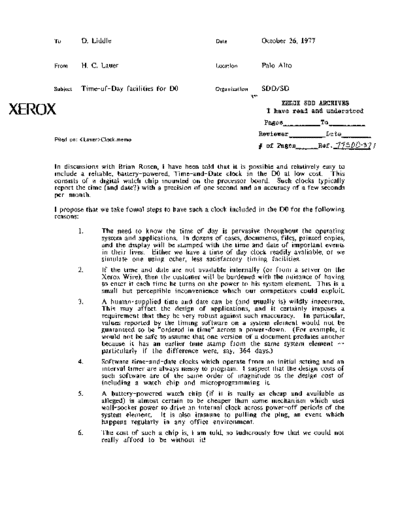Service Manuals, User Guides, Schematic Diagrams or docs for : xerox sdd memos_1977 19771026_Time-of-Day_Facilities_For_D0
<< Back | HomeMost service manuals and schematics are PDF files, so You will need Adobre Acrobat Reader to view : Acrobat Download Some of the files are DjVu format. Readers and resources available here : DjVu Resources
For the compressed files, most common are zip and rar. Please, extract files with Your favorite compression software ( WinZip, WinRAR ... ) before viewing. If a document has multiple parts, You should download all, before extracting.
Good luck. Repair on Your own risk. Make sure You know what You are doing.
Image preview - the first page of the document

>> Download 19771026_Time-of-Day_Facilities_For_D0 documenatation <<
Text preview - extract from the document
To D. Liddle Date October 26, 1977
From H. C. Lauer Location Palo Alto
Subject Time-of-Day facilities for DO Organization SOD/SO
Y"
XEnOX SDD ARCHIVES
XEROX I have read and understood
Pages _________ To _________
Reviewer Date_ _ __
Filed on: Clock.memo
# of Pages Ref. 116/)J)~3 7/
In discussions with Brian Rosen, I have been told that it is possible and relatively easy to
include a reliable, battery-powered, Time-and-Date clock in the DO at low cost. This
consists of a digital watch chip mounted on the processor board. Such clocks typically
report the time (and date?) with a precision of one second and an accuracy of a few seconds
per month.
I propose that we take fomal steps to have such a clock included in the DO for the following
reasons:
L The need to know the time of day is pervasive throughout the operating
system and applications. In dozens of cases, documents, files, printed copies,
and the display will be stamped with the time and date of important events
in their lives. Either we have a time of day clock readily avaliable, or we
simulate one using other, less satisfactory timing facilities.
2. If the time and date are not available internally (or from a server on the
Xerox Wire), then the customer will be burdened with the nuisance of having
to enter it each time he turns on the power to his system element. This is a
small but perceptible inconvenience which our competitors could exploit.
3. A human-supplied time and date can be (and usually is) wildly inaccurate.
This may affect the design of applications, and it certainly imposes a
requirement that they be very robust against such inaccuracy. In particular,
values reported by the timing software on a system element would not be
guaranteed to be "ordered in time" across a power-down. (For example, it
would not be safe to assume that one version of a document predates another
because it has an earlier time stamp from the same system element --
particularly if the difference were, say, 364 days.)
4. Software time-and-date clocks which operate from an initial setting and an
interval timer are always messy to program. I suspect that the design costs of
such software are of the same order of magnitude as the design cost of
including a watch chip and microprogramming it.
5. A battery-powered watch chip (if it is really as cheap and available as
alleged) is almost certain to be cheaper than some mechanism which uses
wall-socket power to drive an internal clock across power-off periods of the
system element. It is also immune to pulling the plug, an event which
happens regularly in any office environment.
6. The cost of such a chip is, I am told, so ludicrously low that we could not
really afford to be without it!
c: W. Shultz
W. Lynch
R. Metcalfe
B. Lampson
◦ Jabse Service Manual Search 2024 ◦ Jabse Pravopis ◦ onTap.bg ◦ Other service manual resources online : Fixya ◦ eServiceinfo